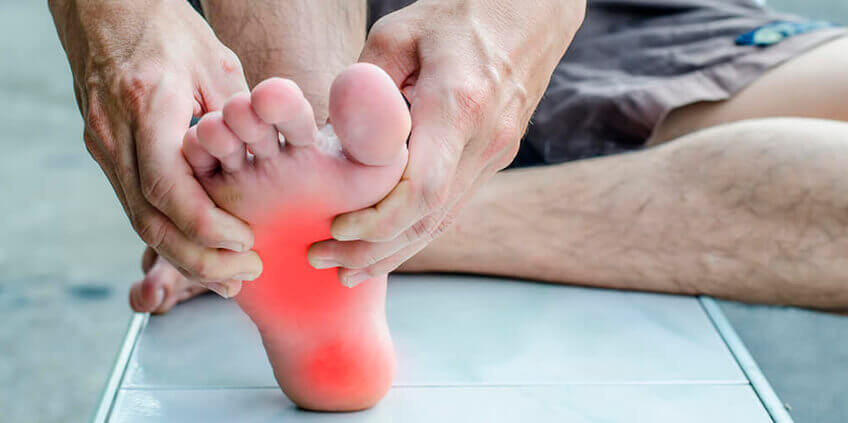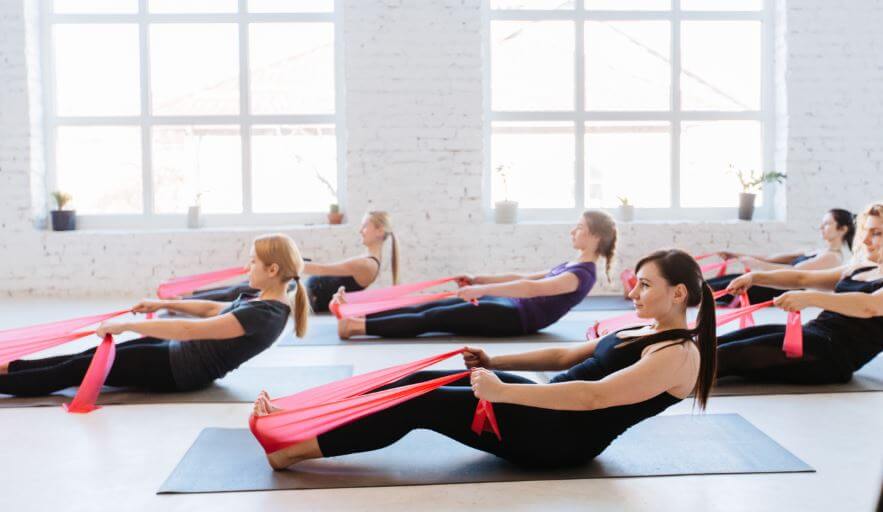The Best Stretches for the Plantar Fascia

Do your feet hurt at the end of the day? Do you feel as if your arches just “give up” sometimes? For those days when tired feet are the norm, try our best stretches for the plantar fascia to let the tension go and relax your sore muscles.
The plantar fascia
Let’s start at the beginning. What exactly are we talking about? The plantar fascia or plantar aponeurosis is an anatomical structure formed by dense connective tissue, which is located on the soles of the feet.
This connective tissue is inserted at the heel and goes up to your toes. When you overwork your feet or stand up for too long, the tissue becomes inflamed. This is called “plantar fasciitis” and many researchers show it can become a serious condition.
Today’s article is all about releasing that tension and inflammation. Using some of our best stretches for the plantar fascia will keep it healthy and pain-free, helping you to avoid injuries.
Structure
To really understand how our stretches for the plantar fascia can help you, we need to know some basic notions of foot anatomy. Underneath all the bony elements of your feet, there’s the plantar arch.
The plantar fascia, as we have said, is a ligament that runs through the lower part of our feet. It runs along its entire length, from the heel to the starting point of our toes.

Function
The plantar fascia has a very important function, none other than maintaining the structure of the feet during walking. As we walk, the fascia stretches and contracts while maintaining the shape of the plantar arch. In addition, the fascia also absorbs the impact of the foot when it hits the ground and prevents the toes from flexing excessively.
When inflammation ensues: plantar fasciitis
Plantar fasciitis is the inflammation of the fibrous tissue that forms the plantar fascia. This usually occurs in people who exercise frequently and who don’t warm up properly.
This inflammation can also be associated with a pathological situation: a calcaneal spur. This is a small bone bump on the calcaneus that contacts the fascia. If you have it, after a training session the little bone will have come in contact several times with the plantar fascia. If you work out, walk or run frequently enough, having a calcaneal spur can cause plantar fasciitis.
The main symptoms of this inflammation are pain when stepping on the floor and swelling in the area. This pain may be accompanied by increased sensitivity in the foot, and may even be painful to the touch.
For people who suffer from this condition, pain is common in the morning, because the fascia is more rigid at this time, and after finishing exercising. Generally, during sports, the patient doesn’t usually show any other symptoms.

The best stretches for the plantar fascia
Stretching your plantar fascia can serve to both prevent and treat plantar fasciitis. First of all, you should definitely consult with a health professional about the most appropriate way to walk, because this is the best way to avoid injuries to the plantar fascia and feet in general.
You might even want to take a stride test with a podiatrist, who will assess your stride and whether you need specific shoes or exercise to walk in a healthy fashion.
In the meantime, here are some stretches for the plantar fascia that can be done at home to relieve pain or to perform after a training session:
- Sitting with one leg resting on the other perpendicularly, take the hand opposite to the leg you want to stretch and grab your toes. Pull on your toes towards your chest, as if you wanted to bring them closer to you. This will stretch your plantar fascia.

Image: trailrun.es
- Another of our favorite stretches for the plantar fascia can be done sitting on the floor. Fully rest your legs on the floor, pressing them together. Next, use an elastic band or even a towel. Grab the elastic band with both hands and loop the band around your foot. Now, pull your hands towards you, stretching your foot.

- To prevent plantar fasciitis it’s also important to stretch your calves, especially after running or jogging. To do this, try to look for a step or an elevated surface. Then, place yourself with half of your feet in the step, and your heels in the air. Next, slowly let your heels down until they touch the floor. You might want to lightly hold on to a wall or other support to avoid falling down. You’ll feel how your calves stretch deeply.

Image: enconishijos.com
Final notes
In general, stretching will help you to maintain a proper elongation of your muscle fibers, especially when done after sports practice.
In addition, stretching will increase blood circulation in the muscles and attached structures, which will help to prevent potentially harmful waste substances that accumulate during physical activity.
This is especially true when it comes to stretching the plantar fascia. Keep these stretches for the plantar fascia in a consistent rotation and soon enough you’ll feel your feet much healthier and pain-free.
Do your feet hurt at the end of the day? Do you feel as if your arches just “give up” sometimes? For those days when tired feet are the norm, try our best stretches for the plantar fascia to let the tension go and relax your sore muscles.
The plantar fascia
Let’s start at the beginning. What exactly are we talking about? The plantar fascia or plantar aponeurosis is an anatomical structure formed by dense connective tissue, which is located on the soles of the feet.
This connective tissue is inserted at the heel and goes up to your toes. When you overwork your feet or stand up for too long, the tissue becomes inflamed. This is called “plantar fasciitis” and many researchers show it can become a serious condition.
Today’s article is all about releasing that tension and inflammation. Using some of our best stretches for the plantar fascia will keep it healthy and pain-free, helping you to avoid injuries.
Structure
To really understand how our stretches for the plantar fascia can help you, we need to know some basic notions of foot anatomy. Underneath all the bony elements of your feet, there’s the plantar arch.
The plantar fascia, as we have said, is a ligament that runs through the lower part of our feet. It runs along its entire length, from the heel to the starting point of our toes.

Function
The plantar fascia has a very important function, none other than maintaining the structure of the feet during walking. As we walk, the fascia stretches and contracts while maintaining the shape of the plantar arch. In addition, the fascia also absorbs the impact of the foot when it hits the ground and prevents the toes from flexing excessively.
When inflammation ensues: plantar fasciitis
Plantar fasciitis is the inflammation of the fibrous tissue that forms the plantar fascia. This usually occurs in people who exercise frequently and who don’t warm up properly.
This inflammation can also be associated with a pathological situation: a calcaneal spur. This is a small bone bump on the calcaneus that contacts the fascia. If you have it, after a training session the little bone will have come in contact several times with the plantar fascia. If you work out, walk or run frequently enough, having a calcaneal spur can cause plantar fasciitis.
The main symptoms of this inflammation are pain when stepping on the floor and swelling in the area. This pain may be accompanied by increased sensitivity in the foot, and may even be painful to the touch.
For people who suffer from this condition, pain is common in the morning, because the fascia is more rigid at this time, and after finishing exercising. Generally, during sports, the patient doesn’t usually show any other symptoms.

The best stretches for the plantar fascia
Stretching your plantar fascia can serve to both prevent and treat plantar fasciitis. First of all, you should definitely consult with a health professional about the most appropriate way to walk, because this is the best way to avoid injuries to the plantar fascia and feet in general.
You might even want to take a stride test with a podiatrist, who will assess your stride and whether you need specific shoes or exercise to walk in a healthy fashion.
In the meantime, here are some stretches for the plantar fascia that can be done at home to relieve pain or to perform after a training session:
- Sitting with one leg resting on the other perpendicularly, take the hand opposite to the leg you want to stretch and grab your toes. Pull on your toes towards your chest, as if you wanted to bring them closer to you. This will stretch your plantar fascia.

Image: trailrun.es
- Another of our favorite stretches for the plantar fascia can be done sitting on the floor. Fully rest your legs on the floor, pressing them together. Next, use an elastic band or even a towel. Grab the elastic band with both hands and loop the band around your foot. Now, pull your hands towards you, stretching your foot.

- To prevent plantar fasciitis it’s also important to stretch your calves, especially after running or jogging. To do this, try to look for a step or an elevated surface. Then, place yourself with half of your feet in the step, and your heels in the air. Next, slowly let your heels down until they touch the floor. You might want to lightly hold on to a wall or other support to avoid falling down. You’ll feel how your calves stretch deeply.

Image: enconishijos.com
Final notes
In general, stretching will help you to maintain a proper elongation of your muscle fibers, especially when done after sports practice.
In addition, stretching will increase blood circulation in the muscles and attached structures, which will help to prevent potentially harmful waste substances that accumulate during physical activity.
This is especially true when it comes to stretching the plantar fascia. Keep these stretches for the plantar fascia in a consistent rotation and soon enough you’ll feel your feet much healthier and pain-free.
All cited sources were thoroughly reviewed by our team to ensure their quality, reliability, currency, and validity. The bibliography of this article was considered reliable and of academic or scientific accuracy.
- Schwartz EN, Su J. Plantar fasciitis: a concise review. Perm J [Internet]. 2014 [cited 2019 Apr 2];18(1):e105-7. Available from: http://www.ncbi.nlm.nih.gov/pubmed/24626080
- Tahririan MA, Motififard M, Tahmasebi MN, Siavashi B. Plantar fasciitis. J Res Med Sci [Internet]. 2012 Aug [cited 2019 Apr 2];17(8):799–804. Available from: http://www.ncbi.nlm.nih.gov/pubmed/237989503.
This text is provided for informational purposes only and does not replace consultation with a professional. If in doubt, consult your specialist.








